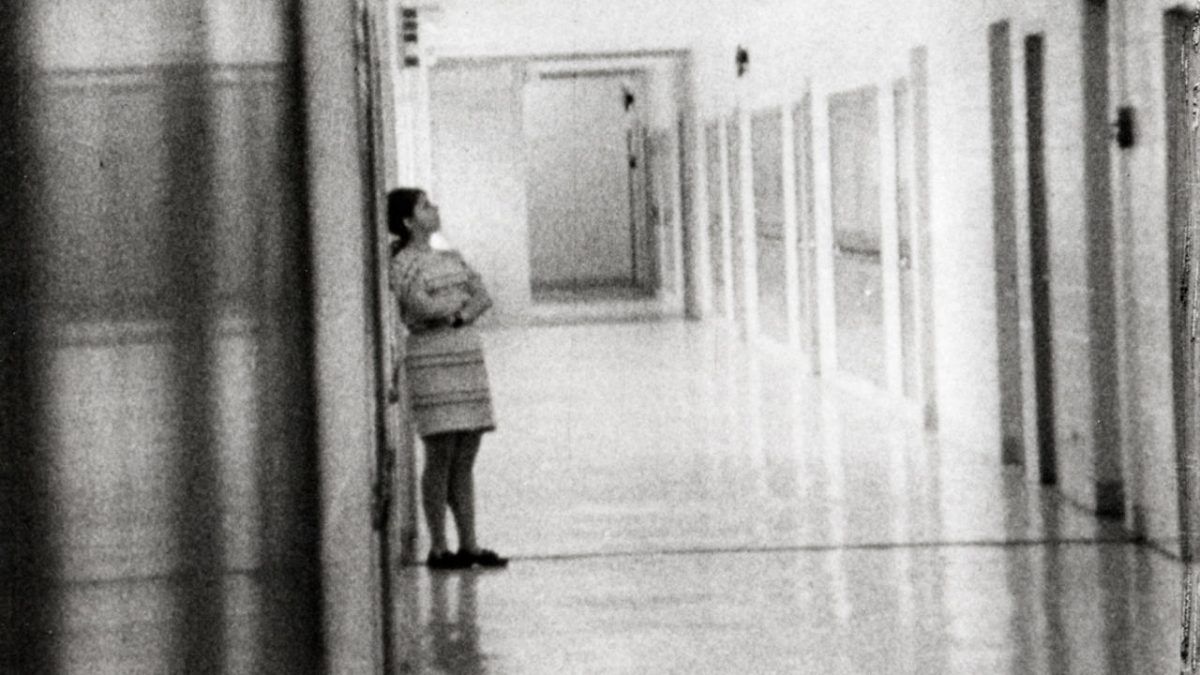The films of Frederick Wiseman may not be considered ‘accessible’ by many, and that is not due to the difficulty of finding them. Almost all of Wiseman’s films can be found for free viewing on YouTube or Kanopy (a film streaming service which is available at most libraries). Rather, what makes Wiseman’s films ‘inaccessible’ is the lack of appeal to popular sensibilities as to make an ‘engaging’ film.
Wiseman is alive and well at 95, and has been making films for over five decades; all in the same consistent format. He directs, produces, and edits all of his own films, all of which are documentaries (although he dislikes the label) and made in what many call ‘direct cinema’ or ‘cinema-verite’ style. This means they lack commentary, interviews, or non-diegetic music and focus on ‘the reality’. His films range from one to five hours in length and almost all are centered around a specific institution. Topics such as military (Basic Training), performing arts (Ballet), mental institutions (Titicut Follies), life in small towns (Monrovia, Indiana), libraries (Ex-Libris), and many other similar institutions.
The capacity to use film as a format to document life is arguably the purpose of film, and I believe there are few filmmakers who succeed in this goal more than Frederick Wiseman. Consequently, the use of film to document also puts people at the forefront of cinema, with the sheer humanity of Wiseman’s films being what truly draws me to them. People in his films exist in a natural state of being, with little to no acknowledgement of the camera; however, he does ask the people he’s filming for permission before or after filming. One could say this non-narrative form of filmmaking is boring, or that there is little to no value in spending time watching a film that offers little entertainment value. Which is a sentiment I have to politely disagree with.
Already, due to time, Wiseman’s films offer a purpose–obviously documentation–but specifically historical documentation. As time has passed, and Wiseman’s films have grown older, the footage preserves a time period far removed from the one we live in. As someone who has longed to spend a day walking through a different time period, Wiseman’s films offer an appeal to this desire. In some way, they offer a similar purpose to me as the early films of the Lumiere Brothers and other early filmmakers during the turn of the 20th century offered to their turn of the century audiences. Films like La sortie de l’usine Lumière à Lyon (1895), which is the first film to be shown to a paying audience, display similar elements to Wiseman’s films; such as documenting the somewhat mundane lives of ‘regular’ people. However, other than the obvious difference in time, a key difference between the films by Lumiere and and the films by Wiseman is the audience. In the times of the Lumieres, the format of film had largely been used as a form of narrative storytelling. This is drastically different compared to films like that of Wiseman’s, which have to compete with the majority narrative fim market, which Wiseman at some point has lost with the small minority that documentary cinema makes up of the films produced since 1900. The audience of the Lumiere brothers was thrilled by their film’s new brand of technology, not due to their stories. In a way, I believe I have similar thrill as that of the viewers of La sortie de l’usine Lumière à Lyon in 1895 did, but with Wiseman’s films. Seeing life accurately portrayed with good cinematography is something of a marvel in itself, even if it has lost some appeal to a general audience.
One of my favorite examples of this ‘historical’ documentation is the 1989 film Central Park, which focuses on what you would expect: Manhattan’s Central Park. There are many beautiful shots of 80s New Yorkers going about their daily lives: all in wonderfully eighties fashion. Among this more provincial footage, there are also more scenes which are more narrative in aspects; arguments between cops and people trying to sell protest shirts and town hall discussions over whether or not to build a new tennis court. My personal favorite moment is at some sort of dinosaur balloon release (the event goes somewhat unexplained), where a competition is held to see who can make the best dinosaur roar. Absurd moments like this make Central Park (and many other films by Wiseman) infused with an unprecedented sense of dry humor. Like most of his other films, there is also a clear focus on community, and the film seems to almost show a bit of veneration to Central Park and the public institutions which fund it (although this is just my own interpretation).
The human interactions within Wiseman’s films also can be incredibly interesting to watch, if not only for the somewhat ‘natural’ aspect of them. Although there is clear use of critically determining what to film and what to add to the film (apparently Wiseman and his crew typically film 100 hours per film), there is still some semblance of what you could call reality. One of my favorite aspects of his films is his somewhat critical portrayal of bureaucratic institutions. This isn’t to say that these films openly mock institutions, although there can be interpretation of some behind the camera criticism. Especially throughout his earlier career, Wiseman faced backlash for his films; primarily from some of the institutions which were the subject.
For example of criticism from institutions where he filmed, Frederick Wiseman’s first feature, Titicut Follies (1967), was banned from being shown in the USA for ‘violating the privacy’ of those in it. There is some verity in this choice; Titicut Follies, is a disturbing film following the mistreatment of inmates in Bridgewater, Massachusetts Correctional Institution for the criminally insane. Throughout the whole film, the viewer is constantly exposed to the degrading and bullying that the wardens give to the patients/inmates.
A particularly shocking scene displays the rather haphazard feeding of an inmate there through a tube in the nose, interposed with the footage of the same inmate later being embalmed. These disturbing scenes are contrasted with footage of a musical revue the same inmates perform yearly which the film gets its name from (the title is Titicut Follies -like a play on the Ziegfeld Follies- a popular entertainment group during the turn of the century). The dichotomy between the inmates singing jolly tin-pan alley songs and the sad world-weary look on their faces is incredibly eerie. The highly voyeuristic nature of Follies is morally grey; how had Wiseman and his crew felt comfortable shooting it without making any protests? There is some sort of reason for why; if they had said anything then they probably would not have been able to continue filming. Follies, in a way, functions similarly to how Nellie Bly’s expose on insane asylums functioned. They both served the purpose of bringing attention to the realities of how mental patients are treated, and both also used a sort of investigative approach, which consisted of not making protests on the conditions while there. Follies did, apparently, cause change at Bridgewater; where after harsh criticism from the public after the film, there were reforms made. Still, despite the film’s success at bringing reform, the argument that Follies is exploitative is still very valid. Wiseman himself has acknowledged this at a Q&A at Film Forum: where he said he would have made the film differently if he had made it for more experience. The film has now gained a bit of infamy after its release to general audiences in 1991 (after all the inmates pictured had passed).
Another large appeal to Wiseman’s films is the platform it provides for more marginalized people. A common theme throughout his work is the inclusion of documentation of the disadvantaged and disabled. It can be somewhat tiring to watch films which portray disabled or homeless people in a clearly biased or unrealistic way, and, in Wiseman’s films, these people are treated by the camera equally to everyone else. No one is really given a different portrayal, and the way they act in the film is truly the real way they behaved and what they did in the ‘scene.’ There is also a lack of ‘main characters’ although there are occasionally recurring ‘scenes’ of the same person. His films almost work as vignettes: showing how a large array of different people have differing experiences in the same situation.
One of the many aspects of Wiseman’s filmmaking which sets him apart is his rather analog approach to filmmaking. For the most part, there has been little difference in the way Wiseman has shot his films from his beginning in the 60s to now. As clarified with an interview with The American Society of Cinematographers, during the first half of his career, Wiseman shot on black and white film stock rather than digital and in the 1980s, when he switched to color film, as it became cheaper and more widely available and in recent years, he has switched to using digital HD film for the same reasons. According to a 2008 interview with The Threepenny Review, instead of digitally editing, he edits by hand: trimming unwanted film. This analog aspect of editing is actually somewhat necessary to making a Wiseman film, due to the fact that almost all sense of story (although not quite narrative) is found in the editing process; rather than while filming or prior to filming. In fact, most aspects of Wiseman’s films are rather spontaneous: he only spends a few days filming, and there is little to no preparation.
In finding Wiseman’s films within this past year, they have found somewhat of a treasured place in my heart. The difference between Wisemans’ films and a majority of almost all other films (although there are some films and filmmakers who are similarly wonderful) brings a certain intense breath of fresh air. Even if it can be argued that the fly-on-the-wall technique employed in Wiseman’s films can occasionally be exploitative or voyeuristic, they offer a perspective so different from anything else. The prolificness of Wiseman also, thankfully, provides an almost never ending amount of content to watch. In the spirit of Wiseman, and his clear support of libraries and public media all of his films have been released under his own film distribution company, Zipporah Films, which is funded by PBS, and consequently is available for free viewing on Kanopy. I highly recommend you give it a try. In doing so, you support the free broadcast of media to the public and a wonderful filmmaker: all you need is a library card.










A Frederick Fan • Nov 13, 2024 at 9:29 am
I’m so happy to see a young person discover Frederick Wiseman! I enjoyed this article very much.